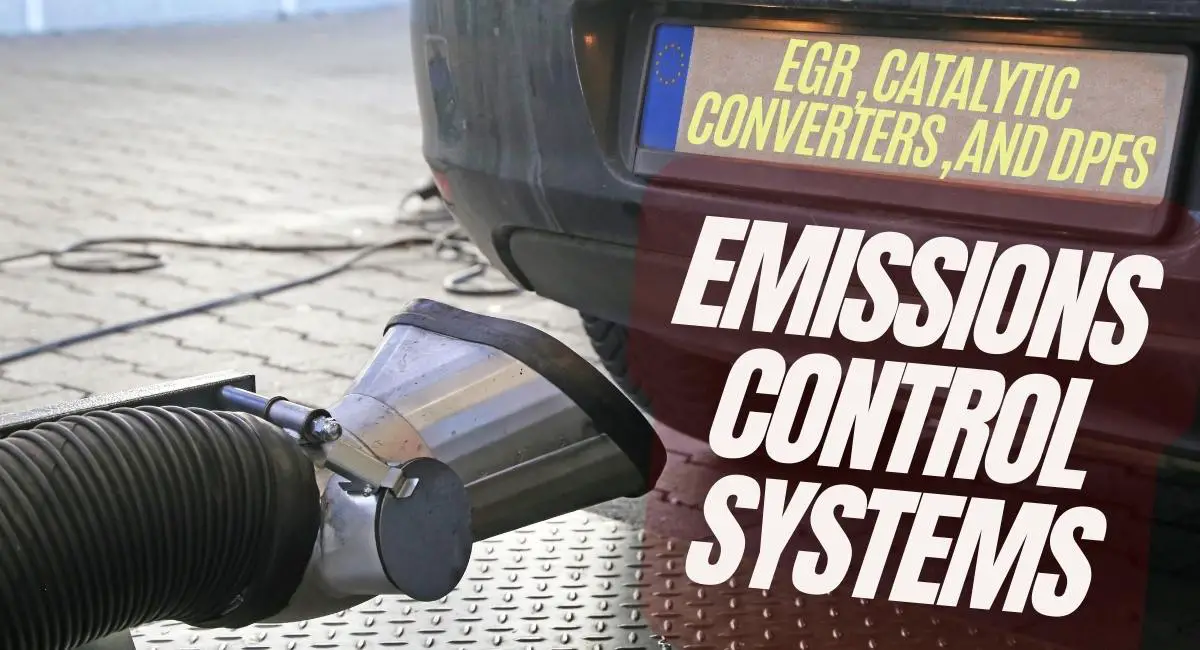In our modern era, the automotive industry faces a dual challenge – delivering high-performance vehicles while minimizing their environmental impact. One crucial aspect of this endeavor is the implementation of effective emissions control systems.
Emission control systems regulate the discharge of harmful gases from vehicles, curbing the release of hydrocarbons, carbon monoxide, and nitrogen oxides. Sources like engines, crankcases, fuel tanks, and carburetors contribute to these emissions.
This article will explore the inner workings and significance of three key components: the Exhaust Gas Recirculation (EGR) system, catalytic converters, and Diesel Particulate Filters (DPF). Understanding their functions and maintenance can help us pave the way towards cleaner air and a sustainable future.
Exhaust Gas Recirculation (EGR) System: Function and Importance
An Exhaust Gas Recirculation (EGR) system is a device that reduces the emissions of nitrogen oxides (NOx) from internal combustion engines. NOx are harmful pollutants that contribute to smog and acid rain.
Have you ever wondered how the EGR system works? By recirculating a portion of the exhaust gases back into the engine’s intake manifold, the EGR system lowers the combustion temperature and the amount of oxygen in the cylinder. It reduces the formation of NOx and improves fuel efficiency. EGR systems are widely used in modern vehicles to meet stringent environmental regulations.
Components of the EGR system include the EGR valve and EGR cooler. The EGR valve regulates the flow of exhaust gases, ensuring optimal recirculation. The EGR cooler, on the other hand, lowers the temperature of the recirculated gases before reintroducing them into the combustion process.
The importance of the EGR system lies in its ability to strike a delicate balance between engine performance and environmental concerns. By mitigating NOx emissions, vehicles with EGR systems can comply with stringent emission standards without sacrificing power and efficiency.
However, EGR systems have their challenges. Common issues include clogged EGR passages and faulty EGR valves, which can compromise the system’s effectiveness. Regular maintenance and troubleshooting are crucial to ensuring the proper functioning of the EGR system.

How Does an EGR System Affect Engine Performance?
An EGR system affects engine performance in several ways. By recirculating a portion of the exhaust gases back into the engine, the EGR system helps to:
- Reduce NOx emissions by lowering the combustion temperature and oxygen concentration.
- Improve fuel efficiency by reducing the amount of fuel needed for combustion.
- Prevent engine knock or detonation by reducing the peak cylinder pressure.
- Extend the engine life by reducing the thermal stress on engine components.
However, an EGR system can also have some adverse effects on engine performance, such as
- Reduce engine power and torque by diluting the intake air with inert gases.
- Increase the risk of carbon deposits and clogging in the intake manifold, EGR valve, and EGR cooler.
- Increase the engine noise and vibration by altering the combustion process.
Therefore, a perfect EGR system must have a good design with control to balance performance and emissions.
Catalytic Converter Technology and Emission Reduction
Catalytic converters are another essential component in the arsenal against vehicular emissions. These devices have a design that converts harmful gases, such as carbon monoxide (CO), nitrogen oxides (NOx), and unburned hydrocarbons (HC), into less harmful substances like carbon dioxide (CO2), nitrogen, and water vapor.
The core of catalytic converter technology lies in the catalyst materials, typically composed of platinum, palladium, and rhodium. These metals facilitate chemical reactions that transform harmful pollutants into less harmful compounds.
There are different types of catalytic converters, with the three-way catalytic converter (TWC) being the most common in gasoline-powered vehicles and diesel oxidation catalysts (DOC) prevalent in diesel engines.
You cannot overstate the role of catalytic converters in emission reduction. According to the U.S. Environmental Protection Agency (EPA), catalytic converters in gasoline vehicles can reduce harmful emissions by up to 90%. This statistic underscores the crucial contribution of catalytic converters to improving air quality and meeting stringent emission standards.
Advancements in Catalytic Converter Technology
Advancements in catalytic converter technology continue to drive progress in emission reduction. Innovations such as advanced catalyst formulations and design improvements contribute to increased efficiency in converting pollutants.
Some of the advancements in catalytic converter technology are
Nanostructured Catalysts
Have you ever heard of nanoscale features like nanoparticles, nanowires, or nanotubes? These structures enhance the catalysts’ surface area, activity, and stability. Nanostructured catalysts can improve the performance and durability of catalytic converters by increasing the conversion rates, reducing the catalyst loading, and preventing catalyst degradation.
Precious Metal Coatings
As the name suggests, these are coatings from thin layers of precious metals, such as platinum, palladium, or rhodium, to coat the substrate of the catalytic converter. Precious metal coatings can enhance the catalytic activity and selectivity of the converter by providing more active sites, improving the dispersion of the catalyst, and reducing the poisoning effects of sulfur and other contaminants.
Advanced Exhaust Gas Sensors
These monitor the composition and temperature of the exhaust gases before and after the catalytic converter. Advanced exhaust gas sensors can optimize the performance and efficiency of the converter by providing feedback to the engine control unit (ECU), adjusting the air-fuel ratio, and detecting any malfunction or deterioration of the converter.
Regular maintenance, which includes avoiding fuel and oil contamination, is essential to ensure the longevity and effectiveness of catalytic converters.
Role of Diesel Particulate Filters (DPF) in Reducing Particulate Emissions
A Diesel Particulate Filter (DPF) is a device that reduces the emissions of particulate matter (PM) emissions from diesel engines by trapping and burning the soot particles produced during combustion. PM is a harmful pollutant that can cause respiratory and cardiovascular diseases and contribute to global warming and acidification. Using a DPF, diesel engines can meet the strict Euro 6 emission limit, limiting the PM emissions to 0.005 g/km1.
How DPF Works
A DPF consists of a ceramic honeycomb structure with porous walls that allow the exhaust gases to pass through but block the soot particles. The DPF is usually after the exhaust system’s diesel oxidation catalyst (DOC). The DOC helps oxidize some soot and other pollutants, such as carbon monoxide (CO) and hydrocarbons (HC), before reaching the DPF.
The DPF collects the remaining soot on its walls until it reaches a certain level, which triggers a regeneration process. Regeneration is the process of burning off the accumulated soot by increasing the temperature of the exhaust gases. It can be done either passively, using the engine’s heat, or by injecting extra fuel or air into the exhaust stream. Regeneration converts the soot into carbon dioxide (CO2) and ash, less harmful than PM2.
Several factors, such as the filter structure, the catalyst activity, the soot prediction, the regeneration strategy, and the exhaust heat management, influence the regeneration process of the DPF. These factors are discussed below:
Filter structure
The filter structure affects the pressure drop, the soot loading, and the regeneration efficiency of the DPF. It can be classified into two types: wall-flow and flow-through. Now, what are the wall-flow filters? They have alternately plugged channels at the inlet and outlet sides, forcing the exhaust gases to flow through the porous walls and capture the soot.
Flow-through filters have open channels that allow the exhaust gases to flow directly but have a thin layer of porous material on the walls to capture the soot. Wall-flow filters have higher soot capture efficiency and lower back pressure than flow-through filters but have higher regeneration temperatures and longer regeneration times.
Catalyst activity
The catalyst activity affects the oxidation rate and the ignition temperature of the soot. Mostly, the catalyst is coated on the filter substrate or mixed with the soot. It can comprise various materials, such as platinum, palladium, cerium, iron, or manganese.
Moreover, the catalyst can enhance the soot oxidation by providing more active sites, improving the soot dispersion, and reducing the poisoning effects of sulfur and other contaminants. It is also possible for the catalyst to lower the ignition temperature of the soot by facilitating the reaction with oxygen or nitrogen dioxide.
Soot prediction
The soot prediction affects the accuracy and reliability of the regeneration control. But what’s soot prediction? You can say it is the estimation of the amount and the distribution of the soot in the DPF. The soot prediction can be based on different methods, such as pressure-based, model-based, or sensor-based.
Pressure-based methods use the pressure difference across the DPF to infer the soot loading. Model-based methods use mathematical models to simulate the soot formation and oxidation processes. On the other hand, sensor-based methods use sensors to measure the soot concentration, temperature, or electrical properties of the DPF. Each method has advantages and disadvantages regarding complexity, cost, and robustness.
Regeneration strategy
The regeneration strategy affects the frequency and the duration of the regeneration process. It can be classified into two types: continuous and intermittent. So, continuous regeneration maintains a constant low level of soot in the DPF by continuously oxidizing the soot. On the other hand, intermittent regeneration allows the soot to accumulate to a certain level and then oxidize it quickly.
You must know that continuous regeneration requires a high catalyst activity and a low soot ignition temperature, but it also consumes more fuel and produces more NOx. Intermittent regeneration requires precise soot prediction and reliable regeneration control, but it also causes more thermal stress and PM emissions.
Exhaust heat management
Exhaust heat management affects the availability and distribution of heat for the regeneration process. Well, you’ll achieve this by different methods, such as exhaust throttling, intake throttling, fuel injection, air injection, or electric heating.
Exhaust throttling restricts the exhaust flow to increase the back pressure and the temperature of the exhaust gases. Intake throttling restricts the intake airflow to reduce the air-fuel ratio and the combustion temperature and increase the exhaust gas recirculation (EGR).
Fuel injection injects extra fuel into the engine cylinder or the exhaust stream to increase the fuel-air mixture and the combustion heat. Air injection injects extra air into the exhaust stream to increase the oxygen concentration and the oxidation rate.
Finally, electric heating applies an electric current to the DPF to generate heat by the Joule effect. Each method has benefits and drawbacks regarding efficiency, cost, and emissions.
Maintenance and Troubleshooting Tips for Emissions Control Systems
Ensuring the optimal performance of emissions control systems requires proactive maintenance and effective troubleshooting. Here are some tips to keep EGR systems, catalytic converters, and DPFs in top condition:
- Regular Inspections: Perform routine inspections of the EGR system, catalytic converters, and DPFs to identify any signs of wear, damage, or contamination.
- Use Quality Fuels and Oils: Choose high-quality fuels and oils to prevent contamination of the EGR system and catalytic converters. Contaminants can compromise the efficiency of these systems over time.
- Follow Manufacturer Guidelines: Adhere to the manufacturer’s guidelines for maintenance intervals and procedures. Regularly scheduled maintenance helps identify and address issues before they escalate.
- Monitor Engine Performance: Keep a close eye on changes in engine performance, unusual noises, or warning lights on the dashboard. These could be indicators of potential issues with the emissions control systems.
- Address Issues Promptly: If you identify issues, address them promptly to prevent further damage and maintain the overall effectiveness of the emissions control systems.
- Regeneration Process: For vehicles equipped with DPFs, ensure that the regeneration process occurs regularly. Follow the manufacturer’s recommendations on driving conditions that facilitate proper regeneration.
Conclusion
Understanding the intricacies of emissions control systems is paramount in the quest for cleaner air and sustainable transportation. The Exhaust Gas Recirculation (EGR) system, catalytic converters, and Diesel Particulate Filters (DPF) each play a vital role in reducing harmful vehicle emissions.
As technology advances, the automotive industry presents new opportunities to enhance the efficiency of these systems further. By staying informed about the functions, importance, and maintenance requirements of EGR, catalytic converters, and DPFs, we can collectively contribute to a future where vehicles coexist harmoniously with the environment, delivering both performance and environmental responsibility.
